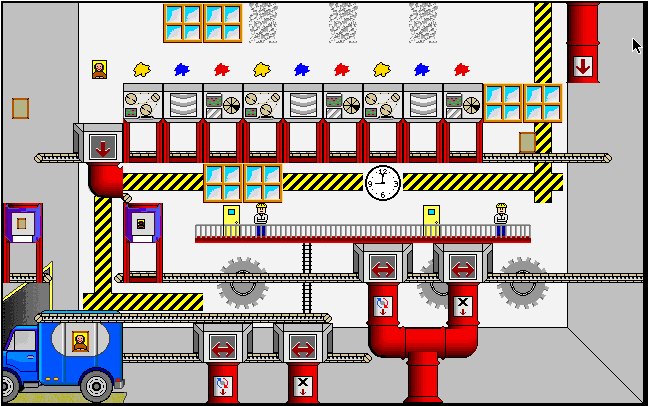Over the last couple of months, I became completely obsessed with a first-person factory simulation game called Satisfactory. As a product builder, I frequently draw inspiration from game design, and I think Satisfactory is a masterpiece in that regard. While it’s still fresh in my mind, I wanted to capture some well-crafted game design elements in this successful game.
Factory Simulations
First off, the relatively new genre of factory simulation games is worth noting. These are essentially puzzle games with some elements of real-time strategy mixed in. More than 20 years ago, I remember playing a game called “Factory: The Industrial Devolution” on my Mac. As far as I know, this was one of the first creations within the factory simulation genre. It had completely captured me back then, and now I understand why.

Factory simulations are essentially state machine builders with different inputs and outputs mixed in. At every step of the process, you need to mine or create increasingly more complicated resources to generate new resources. In return, these new resources unlock new technologies that require even more complicated resources, and so on and so forth.
To someone with an engineering mindset, this is like catnip. Even though there is barely any storyline or other driving elements in many of these games, a certain kind of player (like myself) easily gets addicted to the increasing complexity of managing resources and manufacturing lines.
The first truly successful game in this genre was Factorio. Like many others, it was also my entry point. I deeply enjoyed my play through on Factorio, but I didn’t feel the urge to get back into it. Then came Satisfactory.

Satisfactory
Coffee Stain, the successful game studio behind Goat Simulator and Valheim, entered the factory simulation genre with Satisfactory. Having had significant experience designing similar games before, they managed to mix a few critical elements into an otherwise dry gaming niche.
Immersion
Arguably, the most significant change in Satisfactory compared to other games in the genre is the first-person element. At first, I was really taken aback by this when I watched the game trailer and other videos. However, the moment I started playing it, I understood why they took this route. The world of Satisfactory is beautifully designed, and being able to immerse yourself in that world and in the factories you create is compelling. I think this is one of the big reasons why the game is as sticky as it is.
Storyline and Mystery
There isn’t a massive storyline in Satisfactory. However, Coffee Stain definitely took a page out of Portal’s book in this regard. They kept the storyline simple and mysterious, with unexplained missives coming from off-world giving you directions. There is a corporate control element in there as well, and it all adds up to create a nice little backstory as you go about extracting resources from the virgin planet you are on.
Progressive Enhancement
The core game mechanics and their pacing is perfectly balanced. Due to the sheer number of resources required to go through each level, you end up spending a lot of time designing the manufacturing lines and optimizing them. This usually means a lot of math and pre-planning before jumping into a new factory site. All of this allows the player to progressively get better and better at internalizing the requirements for each type of manufactured resource. In the end, you build some massive factories with gigantic resource lines. However, the game guides you to that point so gently that it doesn’t feel unsurmountable.
Linear Tech Tree
A big part of the successful progressive enhancement is the decision to make the technology tree more or less linear. There are multiple tiers that are unlocked as you progress. Within each tier, the player has some freedom to pick different kinds of technology to unlock. However, at a high-level, it’s fairly linear and forces the player to learn each additional complexity in resource management one by one. This is genius.
Exploration
As I mentioned, the hand-crafted world in Satisfactory is simply gorgeous. They spent a lot of time designing different kinds of climates and fauna, with various exotic animals. Even though there is a small combat element, it never feels dangerous. And exploration itself is a puzzle mechanic on its own, since you can use the factory pieces to reach harder to access points on the map.
Complete Creativity
Finally, the cherry on the cake with Satisfactory is the sheer amount of creative design that’s possible. Players have complete freedom when it comes to designing the manufacturing lines. This is not just cosmetic, but also functional. And I think that element is absolutely key. I rarely spend time or money on cosmetic elements in games, however with Satisfactory I enjoyed getting access to new kinds of factory pieces, so I could design more efficient contraptions for my lines.
So, what are some learnings from a product design perspective? My takeaways are:
- Progressive Enhancement and Linear Path: Forcing users into a single learning path is a very effective tool for onboarding. Satisfactory manages to do this without making it feel like training wheels. Progressively unlocking new features rather than providing access to everything from day one is something more consumer products should consider.
- Alternative Retention Strategies: Offering alternative, immersive mechanics within the application could be a solution to higher retention. Learning a new tool takes time, and we can’t expect users to build new mental models overnight. Alternating “work” with “leisure” while still keeping the user within the platform could be effective.
- Storylines are Strong Drivers: Our brains are story engines. Leveraging simple storylines as effective backdrops to learning and onboarding can be impactful when designing engaging products.
